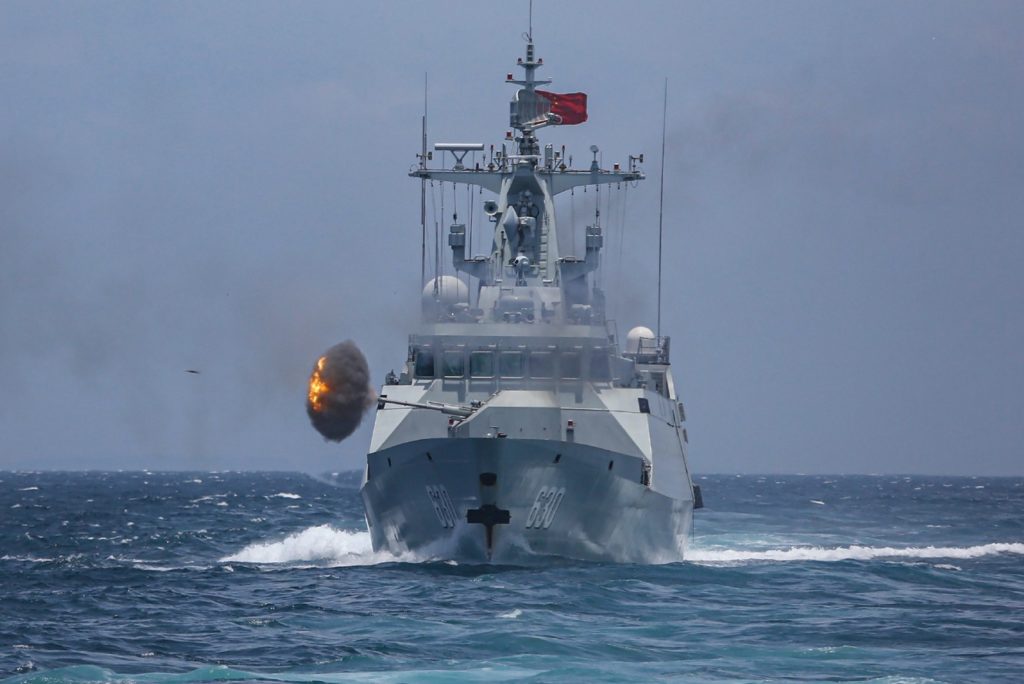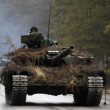By Vincent Kolo, chinaworker.info
The chain of events sparked by Nancy Pelosi’s visit to Taiwan on 2-3 August signals a further escalation of the Second Cold War – the imperialist power struggle between the US and China.
Predictably, Pelosi’s trip brought forth a furious reaction from Xi Jinping’s regime in the form of China’s largest ever live-fire military drills. For a week, the PLA (China’s military) simulated a blockade of Taiwan, deploying over 200 planes, 50 warships, and test-firing some of its latest ballistic missiles over the island. Although at a much-reduced level, the CCP (so-called Communist regime) has continued its military exercises every day since, implying a “new normal” in its military posture.
This show of force has “changed the status quo” in the 180-kilometre Taiwan Strait according to numerous commentators. By this they mean it is now more difficult for Taiwan and its main military allies, the US and Japan, to thwart a future Chinese attack on the island.
Following just six months after Russia’s invasion of Ukraine, the sharp escalation of tensions between Beijing and Washington has raised fears that the world could be on the brink of a new and potentially even more devastating war. Thankfully, that scenario is not realistic in the short-term. But on the basis of crisis-ridden capitalism a fragile and constantly dangerous ‘status quo’ is the best that can be hoped for.
The imperialist power struggle between two increasingly unstable capitalist superpowers is the main driver of global events, and the latest crisis in the Taiwan Strait shows that neither the American or Chinese governments are in full control of processes. The military and diplomatic stances of both regimes are heavily influenced by crisis conditions at home.
Unstable regimes
Biden and the Pentagon advised Pelosi not to go to Taiwan because they wanted to avoid an escalation of tensions at this time. For different reasons a temporary “time out” in the cycle of Cold War escalation would have suited both sides. For Biden there is the dismal state of the US economy, the prospect of losing control of Congress in November’s elections, and pressure to hold together his European allies for a long proxy war against Russia over Ukraine.
Xi’s difficulties are even greater. They include a Japanese-style property crash, shrinking population, an insane self-imposed Covid nightmare (authorities in the coastal city of Xiamen are now testing fish for Covid) and Xi’s ill-timed “alliance” with Putin. Therefore, although the Chinese regime sees taking control of Taiwan as one of its historic missions, it too did not want to escalate tensions at this juncture.
But once Pelosi’s visit became public, the US government had to get behind her or face accusations of caving in to Chinese threats. Xi was similarly backed into a corner, with no option but to escalate or risk being seen as “weak” at a crucial moment, barely two months before his elevation to lifetime ruler.
Among Taiwan’s 23 million people, the Chinese military drills will backfire by reinforcing mass opposition to any idea of unification with China. In the wake of Russia’s invasion of Ukraine polls show 73 percent of Taiwan’s population are willing to take up arms against a Chinese invasion. Riding this wave, Taiwan’s pro-US Democratic Progressive Party (DPP) government has just announced a sharp increase in its military budget for next year by almost 14 percent. The US arms industry, which supplies three-quarters of Taiwan’s weapons, is licking its lips in anticipation.
Just as Putin miscalculated on an epic scale, failing to recognize the national question in Ukraine, which has been a decisive factor behind Russia’s disastrous military showing, Xi’s aggressive “wolf warrior” stance is guaranteed to arouse ever greater opposition from Taiwan’s population.
Shifts in US policy
Pelosi is the Speaker of the US House of Representatives and the third highest-ranking US official (after Biden and Kamala Harris). Consequently, her visit was seen by Beijing as a significant further step in a process whereby US imperialism is incrementally transitioning away from its longstanding official stance on Taiwan. That is to oppose Taiwan independence but also any use of force by China.
Beijing accuses the US government of “hollowing out” – a valid description – its own one China policy (not the same as China’s one China principle). Under this decades-old diplomatic formula Washington formally recognizes only the People’s Republic of China and its government, while not officially recognizing but nonetheless maintaining “robust unofficial ties” with Taiwan (official name: Republic of China).
The convoluted diplomatic precepts that surround this relationship arose from deals struck in the 1970s between the then Stalinist Chinese regime and US imperialism, which facilitated their rapprochement and China’s switch into the Western camp during the original Cold War. The dictatorship that ruled Taiwan was diplomatically downgraded (and hurled out of the United Nations) by its Western allies in pursuit of a much bigger strategic prize: a bloc with Stalinist China against the Soviet Union. This US-China axis came to play an important role in the worldwide collapse of the Stalinist one-party dictatorships at the end of the 1980s.
To maintain vital leverage over both regimes in Taipei and Beijing, however, and in the name of “preserving peace” across the Taiwan Strait, the US passed the Taiwan Relations Act under which it is obligated to help Taiwan defend itself against China by selling it arms. This policy leaves unanswered the question whether the US military would directly intervene, under a doctrine known as “strategic ambiguity”.
As the US-China conflict sharpens the US is stepping up its military and diplomatic support for Taiwan, not out of any concern for “democracy” or “the rights of small nations”, but as a lever against Chinese imperialism and in preparation for a possible future war for control over the island. Some circles within the US ruling class are now looking to the Ukraine war as a possible template for a future proxy war against China, to isolate and exhaust the resources of the Chinese regime, much as US Defense Secretary Lloyd Austin spoke of the Ukraine war producing a “weakened” Russia.
The democratic rights of the Taiwanese masses including freedom of speech (up to a point), the right to vote (for capitalist politicians only), the right of workers to organize trade unions and to strike (again, subject to limitations), these are important if still fragile achievements from the standpoint of the workers’ movement. But these play no role in the calculations of US imperialism, which for four decades supported a brutal dictatorship in Taiwan.
High stakes conflict
For both Washington and Beijing, the stakes in this conflict are huge. Firstly, this concerns Taiwan’s critical role in the tech war between the two camps, due to the island’s overwhelming dominance of the global semiconductor industry. Taiwan makes 65 percent of the world’s chips and 92 percent of the most advanced chips. On 25 August, Biden signed the US$280 billion Chips and Science Act, which has been described as a “milestone” in the US-China tech war, with the aim of reviving US production of semiconductors.
But Taiwan’s significance goes far beyond technology. No capitalist government in China could acquiesce to Taiwanese independence. This would deal a crippling blow to its ability to rule over a centrifugal state, with pressures from Hong Kong, Xinjiang, Tibet, and other regions to reject control from Beijing.
During this year’s months-long lockdown of Shanghai, China’s largest and wealthiest city, calls for “Shanghai independence” surfaced on social media albeit on a small scale. A relatively more widespread phenomenon has been the belated outpouring of sympathy and understanding for the 2019 mass democracy protests in Hong Kong. Tensions between the regions and the center will become stronger as China’s economic malaise deepens, which is inevitable because the so-called economic miracle is over and a ‘Japanese chapter’ of low-to-zero growth has taken its place. Therefore, for Chinese imperialism the Taiwan issue is about the survival of their state, of capitalist rule, and the suppression of internal contradictions.
For the US side, the contest also has an existential character. Its Cold War strategy aims to shore up America’s post-1945 dominance in the Indo-Pacific, the decisive region of global capitalism in the 21st Century. The loss of Taiwan – its subjugation by the Beijing regime – would represent a historic defeat for US imperialism with far greater repercussions than its humiliation in the Vietnam war. Such an outcome would force a dramatic power realignment of states and governments across the Indo-Pacific in China’s favor. America would find itself relegated to continental-power status.
To this end US imperialism, while in words still adhering to its blurry one China policy and other diplomatic protocols from the 1970s, is in practice shifting towards a strategy of “normalization” of Taiwan’s separate status, which of course was the point of Pelosi’s visit. This also explains Joe Biden’s series of supposed gaffes, in which the president has stated emphatically that the US would intervene militarily in the event of a Chinese invasion of Taiwan, only to be contradicted by his own officials. A policy of “strategic confusion” has thus supplanted the former “strategic ambiguity”.
Forces on the right of the US political map want to go further with several voices in Congress and in the Republican Party favoring formal recognition of Taiwan as an independent state. The notoriously hawkish John Bolton, one of several Republicans who supported Pelosi’s trip, while Trump slammed her as a “trouble maker”, argues that the US, “should exchange full diplomatic recognition [with Taiwan], embassies, the whole nine yards, and so should other countries”.
China’s position
Xi’s regime had for months tried to get Pelosi’s Taiwan visit cancelled. Originally, she planned to visit the island in April but that was cancelled when she tested positive for Covid. In July, when her August itinerary became known, the Chinese regime went into overdrive to warn the US side of “serious consequences”. Such statements are not uncommon for the Chinese regime in matters concerning Taiwan but this time the messages were more pointed. The response would be “unprecedented” it warned.
Beijing’s vehemence was due to several factors including Pelosi’s rank, but the main factor was the timing of the visit during an acute period of crisis and internal power struggle for Xi Jinping. A stream of US and other foreign dignitaries have visited Taiwan before and since Pelosi’s visit, most recently delegations from Japan and Lithuania, using Taipei as a stage for taking Cold War selfies. Sometimes the Chinese regime has ignored these visits. It might have elected to do so this time, but that option became impossible due to the depth of the current economic and social crisis in China and the weakening of Xi’s position which has resulted.
Therefore, on 4 August, the day after Pelosi left the island, the PLA showed its hand. The Chinese war games which lasted a whole week were unprecedented not only in scale but also for their proximity to the coastal waters of Taiwan. Six drill zones effectively encircled the island from every direction. This amounted to a dress rehearsal not for an invasion, but for a blockade of the island and the Taiwan Strait. A blockade is one possible future scenario by which the CCP hopes it could force Taiwan to capitulate to its demands.
While this was a major show of strength by China’s military, showcasing significant strides forward in terms of technology and coordination, what did the exercises actually achieve? The message Beijing wanted to send was that the PLA now has the upper hand and can whenever it chooses lockdown the Taiwan Strait, through which nearly half the world’s container shipping passes, and sever Taiwan’s links with the rest of the world.
Supplementary to that strategy, on 13 July, China’s foreign ministry spokesperson Wang Wenbin stated that in Beijing’s eyes the designation “international waters” does not apply to the Taiwan Strait. This announcement, of course dismissed by US imperialism and its allies, replicates the “grey zone tactics” the CCP has deployed in the South China Sea to extend its claims over disputed waters which are subject to counterclaims by other coastal nations including Vietnam and the Philippines.
Grey zone warfare
Grey zone methods are aggressive actions or policies that seek to change the parameters in a given conflict but stop short of open warfare. In the South China Sea, the PLA has built artificial islands and subsequently positioned fighter jets, anti-ship and anti-aircraft missile systems on some of them, to deter rival claimants and strengthen Beijing’s claims of sovereignty over the surrounding waters.
In this way, the Chinese regime claims exclusive control over a maritime area of 3.5 million square kilometers – larger than India. Beijing has refused to negotiate with rival claimants other than on a bilateral (state-to-state) basis, where it enjoys an unequal advantage. In 2010, Yang Jiechi who was at that time China’s foreign minister, famously told an ASEAN foreign ministers’ meeting: “China is a big country and you are small countries and that is a fact”.
The PLA’s post-Pelosi drills around Taiwan used similar tactics, for example by repeatedly crossing the ‘median line’ in the Taiwan Strait in order to support the CCP’s claim of sovereignty over the whole waterway. This is a notional, unofficial boundary, but it was largely respected by both sides for decades. In this way, adopting an incremental or ‘salami slicing’ approach, China’s military actions seek to establish new ‘facts on the ground’ to change the balance of power. US imperialism has of course used similar tactics in pursuit of its own interests.
But the real situation is less clearcut than the CCP’s propaganda would suggest, even from a military point of view. The CCP has not succeeded in establishing a ‘no-go area’ for US and foreign military forces in the Taiwan Strait. Nor can it do so short of going to war. This was demonstrated on 28 August when two US guided-missile cruisers, Antietam and Chancellorsville, performed what the US navy called “a routine Taiwan Strait transit” in defiance of China’s claims to control the strait.
The US operation was deliberately delayed by almost three weeks after Pelosi’s visit, and was much smaller than its response during the 1996 crisis (when two US aircraft carrier groups were deployed to the Taiwan Strait). This was a calibrated response which the US judged would not trigger immediate escalation. Accordingly, the Chinese side played down the incident. Even the nationalist Global Times said the presence of the two American cruisers brought “no actual threat to China’s security”. The main focus of the CCP’s propaganda right now is to defuse this issue and prevent nationalist moods from boiling over.
If Beijing chose to enforce an actual blockade of Taiwan rather than a simulation, this would encounter massive pushback from the US and its allies, not least Japan. The latter protested during China’s drills that five of eleven test-fired ballistic missiles landed in Japan’s territorial waters southwest of Okinawa. China’s nationalists cheered the five missiles, but these may actually have missed their targets and landed in Japanese waters by mistake. A Nikkei Asia report noted that Wang Yi, China’s foreign minister, was visibly surprised during an ASEAN summit when he was informed about the missiles.
Whatever the truth of this, the missile incident was a propaganda gift for the Kishida government in pursuing its own militarization agenda. On 21 August, the Yomiuri Shimbun newspaper reported the Japanese government is now considering the deployment of more than 1,000 long-range cruise missiles to “counter threats from China and North Korea”. This would entail upgrading Japan’s existing missiles to extend their range from 100 kilometers to 1,000 kilometers, enough to reach Chinese coastal areas.
Japanese imperialism is hungrily exploiting the current surge in global tensions to flex its military muscles and redress its relative weakening following three decades of economic stagnation. Japan could soon be propelled from ninth place for military spending into third place behind the US and China, according to data from the Stockholm International Peace Research Institute. Japan’s accelerating military build-up is of course only one of many parallel trends.
The AUKUS pact involving the US, Australia and Britain, was specifically set up to counter a Chinese naval blockade of Taiwan. India, which has a long-running border dispute with China, for the first time criticized China for “militarization of the Taiwan Strait”. This is part of the Modi regime’s increasing alignment with US imperialism through the QUAD and other forums even as it attempts to balance by defending Russia’s actions in Ukraine. In October, Indian and US troops will stage joint military exercises in the Himalayas, just 100km from the disputed border with China.
A prolonged blockade of Taiwan would impose heavy losses on China’s economy by disrupting shipping to its key eastern ports including Shanghai, the world’s biggest. This is before the likely global fallout. A PLA blockade of the Taiwan Strait would be classified as an “act of war” and trigger a furious reaction from Western capitalism, likely exceeding the scale of current economic and diplomatic measures against Russia. In other words, for the Chinese regime the stakes would be almost as high with a blockade as with an attempt at a full-blown invasion of the island.
Real and perceived motives
Therefore, a harder look at the CCP’s thunderous reaction to Pelosi’s visit is required. This does not mean as some commentators have concluded that the Chinese side is preparing an invasion of Taiwan in the short term. Nor does it mean that Beijing holds all the cards in respect of a military cordon or blockade of the island.
Despite its military progress, Xi’s regime knows that a military conflict over Taiwan in the here and now would mean a direct conflict with the US, still the world’s greatest military power. Putin’s bungled invasion of Ukraine will have increased Beijing’s wariness about engaging in such a war. Furthermore, a seaborne invasion of Taiwan is militarily a vastly more complicated and risky enterprise than Russia’s land invasion of Ukraine.
It is necessary to separate the bluster and propaganda on both sides from actual intent, by understanding the balance of forces. These can change in the future. But at this stage, mainly because it fears the political consequences of military failure and an economic implosion if Russian-style sanctions are imposed, Xi’s regime does not want to get into war over Taiwan.
Furthermore, the economic crisis in China is so serious at the moment that Xi would have preferred not to stage the August drills, which, while they introduce new strategic complications for the US side, also carry serious downsides for the CCP.
Politically, the PLA’s military demonstration has further played into Washington’s hands in mobilizing US-led anti-China coalitions, not only in Europe and other Western capitalist states, as shown by the G7’s unprecedented condemnation of the Chinese military exercises, but even to a certain extent in Southeast Asia, a key region of US-China rivalry. Here, the messaging surrounding the latest Taiwan Strait crisis is of a rather restrained US reaction counterposed to Chinese “gunboat diplomacy”. Of course, the US side has lost no time in spreading this version of events.
Another major cost of the current standoff will be accelerated economic decoupling from China. Pressure is mounting on Western companies to hedge against a future Taiwan Strait military conflict by relocating at least some of their China investments with a ‘China-plus-one’ strategy. This won’t reach Russian proportions in the short-term, but the longer-term effects for China and the global economy will be much greater.
These realities mean that – for now – the bellicose noises from Beijing are not signs of serious war preparations. In the phone call between Xi Jinping and Joe Biden on 28 July, the Chinese president again tried to put pressure on his US counterpart over Pelosi’s upcoming visit. But during this conversation a more significant message was delivered, as reported by the Wall Street Journal (11 August): “Mr. Xi warned Mr. Biden of unspecified consequences if Mrs. Pelosi went to Taipei, people briefed on the call said. But he also indicated that he had no intention of going to war with the US and said both sides needed to ‘maintain peace and security,’ according to the people.”
The credibility of this report is supported by actual events. Essentially, Xi was tipping the US side off in advance so they would not misread or be overly alarmed by China’s response. It is as if the Chinese leader was saying: I am going to do something that will look very menacing. I have no choice. But please don’t overreact to my overreaction or allow this to get out of hand.
Chinese nationalism
Many commentators including some on the left who overestimate Chinese capitalism’s ascendancy, have missed a key feature of the current crisis: that it is the deepening crisis on the domestic front that dictated Xi’s response. The need to send a warning to US imperialism was also a factor, but not the overriding factor.
This triggered a cycle of diplomatic escalation in the weeks before Pelosi landed on Taiwan, in which sections of the CCP propaganda machine competed against each other in predicting a dire outcome for the House Speaker. As Xi’s rule has become more and more repressive and increasingly incapable of delivering economic growth, he has fostered the growth of reactionary Chinese nationalism through the media and social media.
But China’s nationalist right is now developing Frankenstein tendencies, beyond the control of its creator, which increasingly impinge on government policy, robbing the CCP of a degree of flexibility to adjust its policies as needed. To some extent, the US ruling class faces a similar dilemma with the growth of Trumpism.
The nationalist passions whipped up over Pelosi’s visit and the widespread expectation that Beijing would “never” allow it to take place, hoisted Xi by his own petard. The military exercises were therefore a necessary “performance” to serve as a distraction from the economic slump, surging unemployment, endless ‘Zero Covid’ lockdowns, and to reassure millions of disappointed nationalists whose mood was one of disbelief when they saw Pelosi’s plane touch down at Taipei airport.
On the night of 2 August, more than 200 million people in mainland China watched Pelosi’s arrival in Taipei on livestream. This was thanks to news platforms that genuinely seem to have expected her plane to be diverted by some form of Chinese military intervention, ranging from a possible no-fly zone to Hu Xijin’s widely reposted call for her plane to be shot down. Hu Xijin is a prominent nationalist influencer and former editor of the CCP’s Global Times.
The mood of anti-climax in China’s nationalist circles was crushing. Social media, which accommodates the nationalist right but blocks dissenting content, was full of posts decrying a sense of “national shame” and depicting China as a “paper tiger”.
“Disappointment and anger filled the blogosphere, with videos of citizens banging their tables and throwing their chairs going viral. The next morning, many Chinese said they couldn’t sleep with their frustration boiling over,” reported Katsuji Nakazawa in Nikkei Asia (11 August).
This mood soon turned against the CCP, which shows how nationalism can be a double-edged sword. Many accused Xi’s regime of “lying to them” and being “full of empty talk”. Given the Putin cult that has grown within China’s nationalist right, again facilitated by official CCP propaganda, some compared the Xi regime’s inability to stop Pelosi with the purported “boldness” of the Russian dictator.
CCP power struggle
Xi Jinping is embroiled in a sharp power struggle against the CCP’s anti-Xi factions. Power struggles are endemic not only to CCP rule but all Chinese regimes going back to imperial times. The timing of Pelosi’s visit coincided with a key event in Xi’s calendar, the start of the secretive annual Beidaihe gathering of CCP factional godfathers. At this year’s Beidahei meeting, which is believed to have wrapped up on 14 August, the factional carve-up of top seats was decided, to then be rubber-stamped at the CCP’s 20th Congress which begins on 16 October. Xi could not afford to go into the Beidaihe talks on the back of a weak reaction to the Pelosi affair.
Xi’s position has been substantially weakened during the past year, which increases his reliance on nationalism, anti-US rhetoric and the ‘Taiwan card’ also as weapons in the internal power struggle. While Xi’s dominance is not threatened at the October congress – he will secure an unprecedented third term as CCP boss – it looks increasingly likely he will be forced to make concessions to rival factions in the carve-up of seats within the CCP’s top echelons, the Politburo and Politburo Standing Committee.
Under the above scenario the anti-Xi factions, whose figurehead is Li Keqiang, the current premier, hope to use these positions to check Xi’s power especially in the field of economic policy. But the anti-Xi factions no more than Xi himself have any solution to the capitalist crisis and of course none of them represent the interests of the masses. Opposition to Xi is mainly based on his increased concentration of power and over-the-top nationalism, which has increased China’s global isolation and aggravated its economic crisis. All CCP factions can sense the tremors of coming mass upheavals but they are divided over how their autocratic state can survive.
Taiwan independence
In Taiwan, nationalism is also on the rise. In their impact on Taiwan’s mass consciousness, China’s military drills are of course counterproductive, just as they were in the 1995-96 Taiwan Strait Crisis. This can produce a knee-jerk response of increased support for militarization and “stronger” government in Taiwan, including an extension of anti-democratic laws.
Xi Jinping is thus repeating his accomplishments in crushing mass protests and limited local autonomy in Hong Kong. That was a powerful demonstration to warn off the Americans and placate Xi’s nationalist power base. But in Taiwan its impact was to further fuel independence sentiment and demolish the CCP’s previous strategy for a negotiated unification process based on the Hong Kong model of “one country, two systems”.
Read more ➵ The new Cold War: Getting hotter?
Attitudes towards independence in Taiwan are complex, with the largest demographic (over 82 percent in a recent poll) in favor of keeping the ‘status quo’ i.e. de facto but unofficial independence. This is because a formal declaration of independence would trigger war with China. Only 1.3 percent of Taiwan’s people favor unification with China. The growth of a Taiwanese national identity is an objective fact and not some political trick of the Taiwanese capitalists or the pro-US government of Tsai Ing-wen’s DPP.
At the time of the previous Taiwan Strait crisis in the mid-1990s only 25 percent of the population self-identified as Taiwanese. This has risen to almost 68 percent today. An additional 27.8 percent think of themselves as both Chinese and Taiwanese, a drop from 47 percent in 1995. The Ukraine war has increased fears among Taiwan’s population of a Chinese attack, even if a majority don’t yet believe the threat is serious because they count on US military power to prevent this.
Taiwan’s main opposition Kuomintang (KMT: Taiwan’s former ruling party and US-backed dictatorship) is at a record low 17 percent in opinion polls. This party is damned by two decades of close collusion with the CCP up until it lost the presidency in 2016. Despite the new KMT leadership distancing itself from its former pro-China stance and adopting a more pro-US line, this points towards victory for the DPP in the 2024 elections under whoever succeeds Tsai as presidential candidate.
November’s local elections in Taiwan are a different matter, with the cross-strait conflict less of a factor and KMT mayoral candidates expected to outperform their party’s national ratings. Tsai’s government is beset by scandals including its ineffective response to the trafficking of over 300 Taiwanese workers duped into slave labor by false job offers in Cambodia’s Chinese-run casino industry.
Marxism and the national question
Socialists uphold the position of Lenin and Marxism on the national question, for the right of the Taiwanese people to self-determination including the right to independence. We reject the claims of the CCP and Chinese nationalists that Taiwan is an “inalienable” part of China, just as Lenin and the Russian Revolution of 1917 freed the oppressed nations of the former Russian Empire and gave them the right to choose if they wanted to form independent states or join voluntarily in a socialist federation.
For Marxism, the decisive question is the need to overthrow capitalism and imperialism, which can only be achieved through united struggle by the working class, overcoming national and other divisions. This unity cannot be built if the workers of one nation or region adopt the nationalist ideas and aims of their own ruling class against other workers.
The creation of revolutionary socialist governments and states (not on the distorted Stalinist model of China in 1949) would fast-forward the development of society by placing the economy under democratic control and management by the working class. A revolutionary socialist government would approach all national problems – state borders, rights of national and religious minorities – with sensitivity and a genuinely internationalist spirit. The maximum possible economic and political cohesion is desirable in the building of a socialist society, but this can only be achieved on a voluntary and democratic basis through an appeal to join in building a socialist federation, with no element of coercion, national prestige or chauvinism.
We Marxists advocate a common struggle by workers in Taiwan, mainland China and across the wider region against capitalism, imperialism and autocratic rule, through the building of socialist parties to organize this struggle and offer real leadership. If the Taiwanese people want independence, which is clearly the case today, then the workers’ movement has a duty to support this, not passively as bystanders, but to actively engage in the struggle.
By showing that national independence is impossible under capitalism and imperialism (in Taiwan’s case it is absolutely impossible), a mass socialist force would be able to unmask the hypocritical capitalist leaders of Taiwan nationalism for whom “independence” means in practice to support one imperialist master over another.
A future workers’ movement in China (no genuine workers’ organizations are currently allowed under the dictatorship) needs to show its solidarity with workers in Taiwan, understanding that their struggle against capitalism and for democratic rights, including the right to independence, can become a powerful weapon against both the Chinese and US imperialists and capitalists.
On the basis of the capitalist system new horrors are ahead of us: Cold War escalation and militarism, economic stagnation and regression, climate Armageddon and the danger of devastating wars. ISA and its supporters in Taiwan, China and Hong Kong, explain that only by fighting for an independent socialist Taiwan as part of a wider regional and global revolutionary struggle to sweep away both US and Chinese imperialism and establish international socialism, can peace and security be assured, putting an end to endless and worsening flare-ups of the cross-strait conflict.












